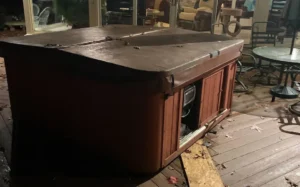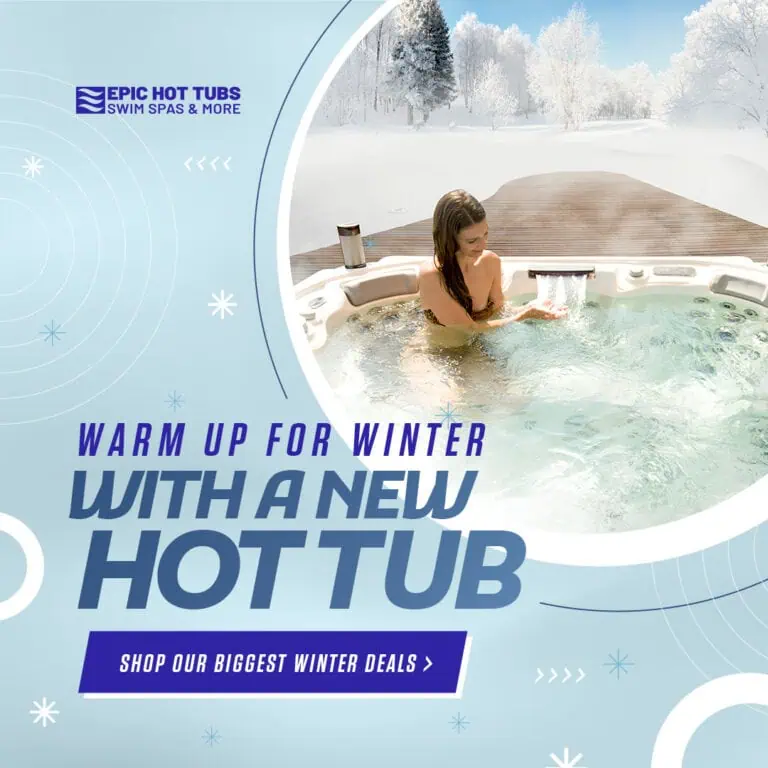How much does it cost to maintain a hot tub? Here's a guide on how…

Is it Worth it to Repair a Hot Tub or Best to Buy a New One?
Struggling with a broken hot tub? Discover when to repair or replace, and make a confident decision. Expert advice to ease your stress and save money.
Facing a malfunctioning hot tub can be frustrating and stressful. You’ve invested time and money into your spa, and now you’re confronted with a tough decision: repair or replace? This dilemma often comes with a mix of emotions – disappointment over the breakdown, anxiety about potential costs, and uncertainty about the best path forward.
Rest assured, you’re not alone in this predicament. Many hot tub owners face this crossroad, and with the right information, you can navigate this decision with confidence.
Quick Answer
| Inspection Item | When to Repair | When to Replace |
| Age | Less than 5-7 years old | Over 10 years old |
| Repair Frequency | Infrequent, minor issues | Frequent, major problems |
| Repair Costs | Less than 50% of replacement cost | More than 50% of replacement cost |
| Energy Efficiency | Minimal efficiency loss | Significant increase in energy bills |
| Technology | Satisfactory features | Desire for modern features |
| Shell Condition | Minor wear, no cracks | Cracked or severely damaged |
| Overall Performance | Generally good | Consistently poor |
Common Hot Tub Problems and Their Impact
Understanding common hot tub problems can help you decide whether to repair or replace your spa. Issues like leaks, heater failures, or weak jets are frequent culprits that disrupt your relaxation. Knowing their typical repair costs and severity can guide your decision-making process.
Leaks, for instance, can range from minor drips to major structural issues. Heater failures often stem from worn elements or electrical faults, while jet problems may indicate pump or plumbing issues. Addressing these early can prevent further damage, but recurring or severe issues may signal it’s time for a hot tub replacement.
| Problem | Typical Repair Cost | Repair or Replace? |
| Minor Leak | $200-$500 | Repair |
| Major Leak | $1,000-$3,000 | Replace if structural |
| Heater Failure | $400-$1,200 | Repair if isolated |
| Weak Jets | $300-$800 | Replace if pump failing |
| Electrical Issues | $500-$1,500 | Replace if frequent |
Hot Tub Repair Near Me: Finding Reliable Services
If you’re dealing with a malfunctioning spa and searching for hot tub repair near me or hot tub repair service near me, it’s important to choose a reliable provider to ensure your hot tub is fixed properly and efficiently.
Look for local hot tub repair experts who specialize in spa repair and have positive reviews from customers in your area. For those with specific brands, such as searching for jacuzzi repair near me, find technicians familiar with your model.
Hot tub repairs in my area should include services like hot tub heater replacement, spa heater replacement, and spa pump repairs. A good service will offer a thorough inspection and transparent pricing.
For inflatable models, such as Intex spas, repair options might differ. If you’re looking into réparation spa intex, dépannage spa intex, or reparateur spa intex, consider if the cost of repair exceeds the price of a new unit, as inflatables are often more affordable.
Similarly, for naprawa jacuzzi dmuchane or reparacion de jacuzzi, the same logic applies to inflatable jacuzzis.
At Epic Hot Tubs, our team provides top-notch hot tub repair services, helping you get back to relaxing in no time.
Detailed Explanation of Inspection Items
Now let’s take a look at these factors in more detail. Each one has specific things you should be looking out for, costs for hot tub repairs, and a kind of “breaking point” where it makes more sense to replace the entire thing.
Age
One common question we hear is “how long does a hot tub last?” or similarly, “how long do spas last?” Understanding the typical lifespan can help you gauge if your hot tub is due for repairs or replacement.
The age of your hot tub is a critical factor in the repair-or-replace decision. Check the manufacturing date, typically found on a sticker inside the equipment compartment or on the shell near the control panel. If you can’t locate this, refer to your purchase documentation or contact the manufacturer with the serial number.

Hot tubs generally have a lifespan of 10-15 years, though this varies based on usage, maintenance, and environmental factors. A well-maintained hot tub in a mild climate might last up to 20 years, while one subjected to harsh conditions or neglect might fail earlier. As hot tubs age, components like pumps, heaters, and plumbing become more prone to failure, and the acrylic shell may show signs of wear or crazing.
For hot tubs over 10 years old, replacement parts can become scarce and expensive, particularly for discontinued models. The cost of replacing major components like the main pump ($500-$1,500), heater element ($200-$500), or control panel ($500-$1,200) can quickly add up. Older models are often less energy-efficient, leading to higher hot tub energy consumption.
A new, energy-efficient hot tub could save you $20-$50 per month on electricity, depending on usage and local rates. When facing significant repairs on an older model, consider that a new hot tub offers improved energy efficiency, better filtration systems, and modern features like smart controls or advanced hydrotherapy options, potentially justifying the higher upfront cost through long-term savings and enhanced enjoyment.
Repair Frequency
Keep a log of repairs your hot tub has required over the past few years. Note the type of issue, date, and cost. Frequent repairs, especially for different components, indicate systemic decline.
Minor issues like replacing a filter or fixing a small leak repair are normal, but persistent problems in the electrical system, plumbing, or major components like pumps and heaters are red flags. Watch for these signs:
- Repairs needed every few months
- Issues with multiple components
- Difficulty finding replacement parts
Constant hot tub costs not only add up financially but also reduce your enjoyment and relaxation time. A hot tub requiring monthly attention could cost you $500-$1,500 per year in repairs alone. If you’re spending more than 10% of the hot tub’s value annually on repairs, hot tub replacement becomes more attractive.
A new hot tub, while a significant investment ($3,000-$15,000 depending on size and features), offers reliability, energy efficiency, and often comes with a multi-year warranty, potentially saving you money and hassle in the long run.
Repair Costs
Comparing Quotes
When assessing hot tub repair costs, get detailed quotes from at least two reputable service providers. Ensure these quotes break down parts and labor separately. Compare these costs to the price of a new hot tub with similar features.
Long-Term Cost Considerations
Don’t just look at the immediate repair; consider the likelihood of future issues. For example, if you’re replacing a pump, how old are the other components? Are they likely to fail soon? Factor in the age and availability of parts for your model.
Major repairs can be costly. A new pump might run $500-$1,500, a heater replacement could cost $400-$1,200, and fixing a significant leak might range from $500 to $3,000 depending on its location and severity. If the total repair cost approaches or exceeds 50% of a new hot tub’s price, replacement is often the better choice.
A new hot tub not only resolves the current issues but also provides updated technology, improved energy efficiency, and a fresh warranty. It eliminates the risk of cascading failures that often occur when one major component is replaced in an aging system.
Energy Efficiency

Checking Insulation
To assess your hot tub’s energy efficiency, review your electricity bills over the past year or two, focusing on months when you use the hot tub most. Modern hot tub meters can provide specific energy consumption data. Compare this to the manufacturer’s original estimates.
Check the insulation quality—older hot tubs often have degraded or inadequate insulation. Feel the cabinet sides when the tub is running; excessive heat indicates poor insulation. Inspect the cover for warping, water absorption, or cracks, which impact heat retention.
Comparing Energy Costs
An inefficient hot tub can add $100 or more to your monthly electricity bill. Older models might use 7-10 kWh per day, while energy-efficient hot tubs can operate on 3-5 kWh daily. This difference could save you $300-$600 annually.
Upgrading to a new, energy-efficient model might cost $5,000-$10,000, but the energy savings, combined with reduced repair needs and improved features, can make this a worthwhile investment. New models feature better pumps, effective heaters, and programmable energy-saving modes.
Technology
Evaluate your current hot tub’s features against those available in newer models. Look at jet quality, customization, water treatment systems, lighting, and control interfaces. Modern hot tubs offer sophisticated hydrotherapy with adjustable jets and targeted massage programs.
Check if your model has a basic control panel or lacks features like remote operation or home automation integration. Newer filtration systems are more efficient, improving water quality and reducing chemical usage, which enhances your hot tub upgrades experience.
Technological upgrades can significantly impact your hot tub experience. Advanced water purification systems (UV-C or ozone) cost $500-$1,500 but reduce chemical usage by up to 50%. Smart controls improve energy efficiency by 5-15% by optimizing heating cycles.
High-end models with these features range from $8,000 to $16,000. If your current hot tub lacks these and shows signs of age, the benefits of upgrading might outweigh the cost of continued repairs and inefficient operation.
Shell Condition
Carefully inspect your hot tub’s shell for signs of damage or wear. Look for cracks, chips, or rough, dull areas, especially around jets, steps, and the waterline. Small blemishes are normal and can often be buffed out for a hot tub shell repair.
Deep cracks or widespread crazing (fine cracks in the gel coat) are serious concerns. Check for soft or spongy areas, which could indicate water penetration. Significant fading or chalking suggests prolonged exposure and potential degradation.
Repairing minor shell damage costs $200-$500, but major cracks or structural issues can run into thousands. A complete shell replacement can cost as much as a new hot tub. Severe shell damage often indicates the hot tub is nearing the end of its lifespan.
In cases of severe shell damage, replacement is usually the most cost-effective option. New hot tubs come with durable acrylic shells that resist UV damage and carry warranties of 5-10 years, providing peace of mind.
Overall Performance
Assess your hot tub’s overall performance by monitoring water temperature stability—it should hold steady without frequent heating cycles. Check jet performance for strong, consistent flow and listen for unusual noises from pumps or blowers.
Evaluate water clarity and how quickly it becomes cloudy after treatment. Note how often you need to add chemicals to maintain water balance. Consider your satisfaction—are you using the hot tub – tub less due to maintenance hassles?
Poor performance increases operating costs and decreases usage. A hot tub struggling to maintain temperature could add $30-$50 monthly in heating costs. Inefficient filtration increases chemical costs by 30-50% and requires more water changes.
Repairing multiple performance issues can exceed $1,000, with no guarantee of resolving underlying problems. For hot tubs over 7-10 years old, replacement often provides better value, with new models costing $6,000-$12,000 for mid-range options.
Hot Tub Maintenance to Extend Lifespan
Regular hot tub maintenance can extend your spa’s lifespan and reduce the need for costly repairs. Simple tasks like cleaning filters and balancing water chemistry prevent issues that lead to breakdowns.
Neglecting maintenance can accelerate wear, making repairs more frequent and expensive. A well-maintained hot tub is more likely to be worth repairing, while a neglected one may require replacement sooner.
- Check pH and sanitizer weekly: Maintain proper water balance to prevent corrosion.
- Clean filters monthly: Rinse and soak to remove debris.
- Drain and refill every 3-4 months: Refresh water to maintain quality.
Benefits of Upgrading to a New Hot Tub
Upgrading to a new hot tub offers significant advantages, especially if your current model is outdated. Energy-efficient hot tubs save $300-$600 annually on electricity, thanks to better insulation and programmable settings.
Modern hot tubs feature advanced hydrotherapy, smart controls, and improved filtration, enhancing relaxation and reducing maintenance. These hot tub upgrades make replacement a compelling option for older, inefficient models.
- Energy savings: Lower bills with efficient pumps and heaters.
- Smart features: Remote control and scheduling for convenience.
- Enhanced comfort: Adjustable jets and ergonomic designs.
The Last Splash
If you’re still unsure about the best course of action, don’t hesitate to seek expert advice. The team at Epic Hot Tubs has years of experience in hot tub maintenance, repair, and sales. They can provide a professional assessment of your current hot tub’s condition and offer personalized recommendations based on your specific needs and budget.
Should you decide that replacement is the best option, Epic Hot Tubs offers a wide range of high-quality, energy-efficient models with the latest features and technology. Their knowledgeable staff can guide you through the selection process, ensuring you find the perfect hot tub for your lifestyle and preferences.
Remember, whether you choose to repair or replace, the goal is to maximize your relaxation and enjoyment. With the information provided in this article and the expertise available at Epic Hot Tubs, you’re well-equipped to make the right decision for your hot tub needs.
Don’t let hot tub troubles stress you out any longer. Contact Epic Hot Tubs today for a consultation or to explore your options for a new, state-of-the-art hot tub. Your path to worry-free relaxation starts here.
Richard Horvath
Richard has been in the hot tub & spa industry for years. As a long hot tub & swim spa owner himself, Richard has a passion for helping homeowners create their dream backyard.



